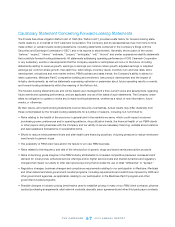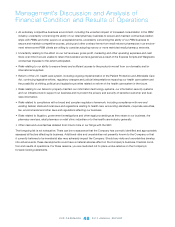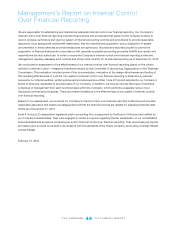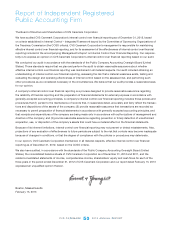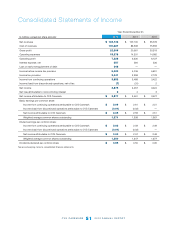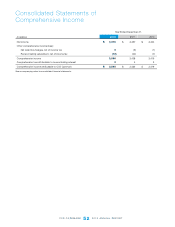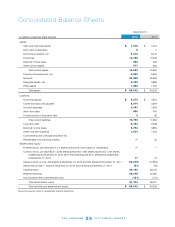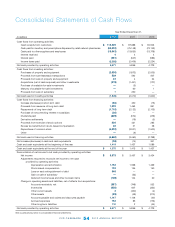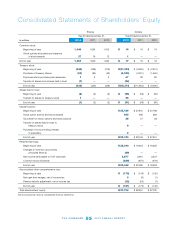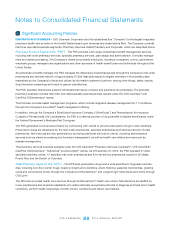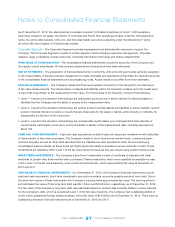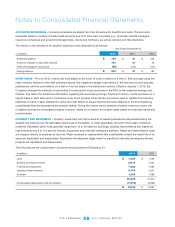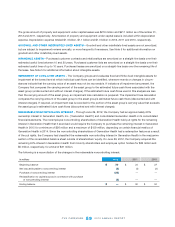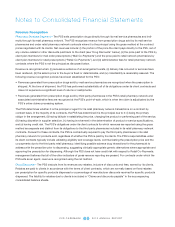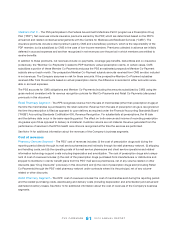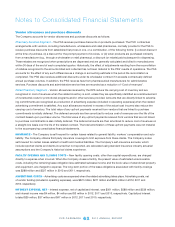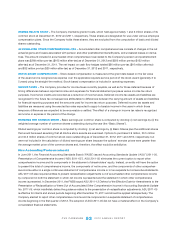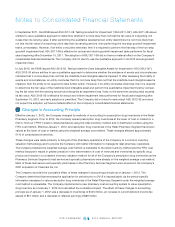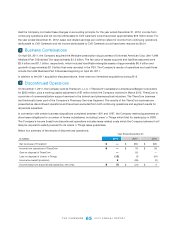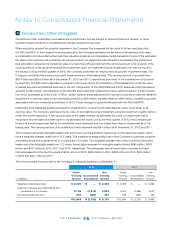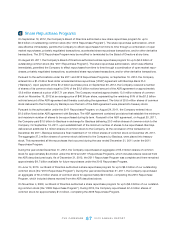CVS 2012 Annual Report Download - page 59
Download and view the complete annual report
Please find page 59 of the 2012 CVS annual report below. You can navigate through the pages in the report by either clicking on the pages listed below, or by using the keyword search tool below to find specific information within the annual report.CVS CAREMARK 2012 ANNUAL REPORT
57
Notes to Consolidated Financial Statements
As of December 31, 2012, the retail pharmacy business included 7,458 retail drugstores (of which 7,402 operated a
pharmacy) located in 42 states, the District of Columbia and Puerto Rico operating primarily under the CVS/pharmacy®
name, the online retail website, CVS.com, and 640 retail health care clinics operating under the MinuteClinic® name
(of which 633 were located in CVS/pharmacy stores).
Corporate Segment –
The Corporate Segment provides management and administrative services to support the
Company. The Corporate Segment consists of certain aspects of the Company’s executive management, corporate
relations, legal, compliance, human resources, corporate information technology and finance departments.
PRINCIPLES OF CONSOLIDATION – The consolidated financial statements include the accounts of the Company and
its majority owned subsidiaries. All intercompany balances and transactions have been eliminated.
USE OF ESTIMATES –
The preparation of financial statements in conformity with accounting principles generally accepted
in the United States of America requires management to make estimates and assumptions that affect the reported amounts
in the consolidated financial statements and accompanying notes. Actual results could differ from those estimates.
FAIR VALUE HIERARCHY – The Company utilizes the three-level valuation hierarchy for the recognition and disclosure
of fair value measurements. The categorization of assets and liabilities within this hierarchy is based upon the lowest level
of input that is significant to the measurement of fair value. The three levels of the hierarchy consist of the following:
• Level1–Inputstothevaluationmethodologyareunadjustedquotedpricesinactivemarketsforidenticalassetsor
liabilities that the Company has the ability to access at the measurement date.
• Level2–Inputstothevaluationmethodologyarequotedpricesforsimilarassetsandliabilitiesinactivemarkets,quoted
prices in markets that are not active or inputs that are observable for the asset or liability, either directly or indirectly, for
substantially the full term of the instrument.
• Level3–Inputstothevaluationmethodologyareunobservableinputsbaseduponmanagement’sbestestimateof
inputs market participants could use in pricing the asset or liability at the measurement date, including assumptions
about risk.
CASH AND CASH EQUIVALENTS –
Cash and cash equivalents consist of cash and temporary investments with maturities
of three months or less when purchased. The Company invests in short-term money market funds, commercial paper
and time deposits, as well as other debt securities that are classified as cash equivalents within the accompanying
consolidated balance sheets, as these funds are highly liquid and readily convertible to known amounts of cash. These
investments are classified within Level 1 of the fair value hierarchy because they are valued using quoted market prices.
SHORT-TERM INVESTMENTS –
The Company’s short-term investments consist of certificate of deposits with initial
maturities of greater than three months when purchased. These investments, which were classified as available-for-sale
within Level 1 of the fair value hierarchy, were carried at historical cost, which approximated fair value at December 31,
2012 and 2011.
FAIR VALUE OF FINANCIAL INSTRUMENTS –
As of December 31, 2012, the Company’s financial instruments include
cash and cash equivalents, short-term investments, accounts receivable, accounts payable and short-term debt. Due to
the short-term nature of these instruments, the Company’s carrying value approximates fair value. The carrying amount
and estimated fair value of total long-term debt was $9.1 billion and $10.8 billion, respectively, as of December 31, 2012.
The fair value of the Company’s long-term debt was estimated based on quoted rates currently offered in active markets
for the Company’s debt, which is considered Level 1 of the fair value hierarchy. The Company had outstanding letters of
credit, which guaranteed foreign trade purchases, with a fair value of $4.9 million as of December 31, 2012. There were no
outstanding derivative financial instruments as of December 31, 2012 and 2011.


